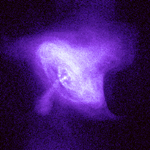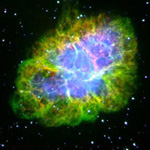This page can be used in conjunction with any of the investigations, tasks, or activities on this page which ask students to compare and contrast images of an object in different wavelengths. These include the CAS Timeline investigation, and the perfomance tasks "Signals from the Cosmos", "Point of View", "The universe Rated R!", "The Crab Through Time", and "Portrait Gallery of the X-Ray Universe".
The Crab Nebula is the remnant of a supernova explosion that was seen on Earth in 1054 AD. It is 6000 light years from Earth. At the center of the bright nebula is a rapidly spinning neutron star, or pulsar that emits pulses of radiation 30 times a second. These images show the Crab as viewed by four different types of telescopes. Comparing the X-ray, optical, infrared, and radio images of the Crab shows that the nebula appears most compact in X-rays and largest in the radio. The X-ray nebula shown in the Chandra image is about 40% as large as the optical nebula, which is in turn about 80% as large as the radio image. This can be understood by following the history of energetic electrons produced by the neutron star. Electrons with very high energies radiate mostly X-rays.
You can view composited images by selecting the combinations you would like to see from the pull down menu on the right and then clicking the "Get Composite" button.


Crab Nebula in X-ray. Chandra's X-ray image of the Crab Nebula directly traces the most energetic particles being produced by the pulsar. This amazing image reveals an unprecedented level of detail about the highly energetic particle winds and will allow scientists to probe deep into the dynamics of this cosmic powerhouse.

Crab Nebula inoptical. As time goes on, and the electrons move outward, they lose energy to radiation. The diffuse optical light comes from intermediate energy particles produced by the pulsar. The optical light from the filaments is due to hot gas at temperatures of tens of thousands of degrees.

Crab Nebula inradio. Radio waves come from the lowest energy electrons. They can travel the greatest distance and define the full extent of the nebula. The Crab's central pulsar was discovered in 1968 by radio astronomers. The pulsar was then identified as a source of periodic optical and X-ray radiation. The periodic flashes of radiation are caused by a beam from the rapidly rotating neutron star.
Crab Nebula Overlays | Crab Nebula Photo Album


